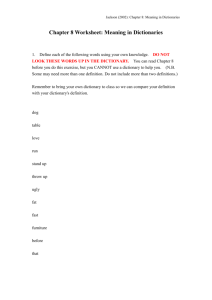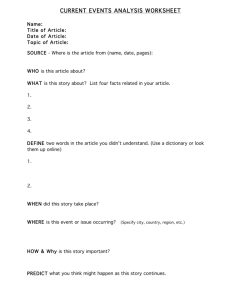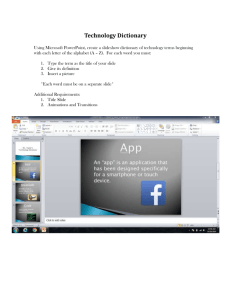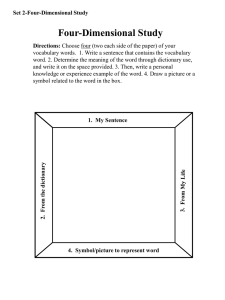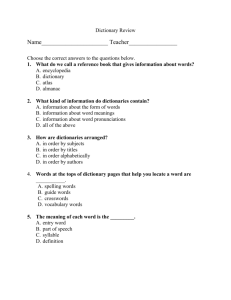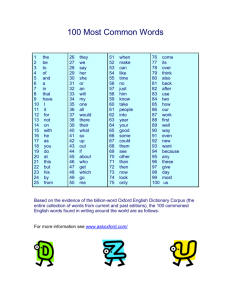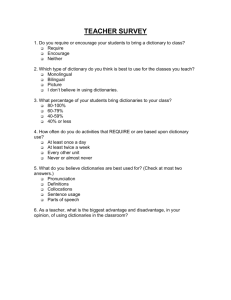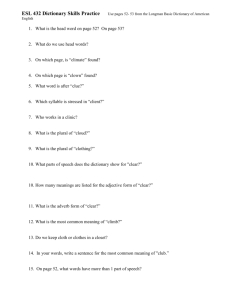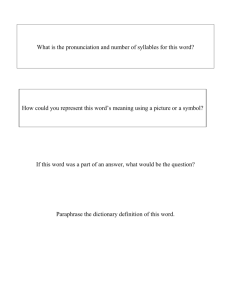Other English-speaking Countries
advertisement
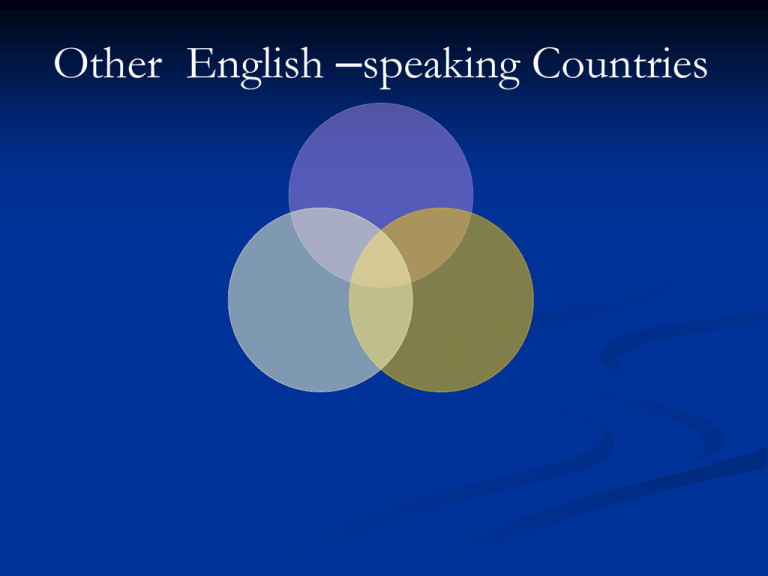
Other English –speaking Countries 2.4.1 Canada The start of dictionaries fromthe 1960s. Most of the dictionaries available imported from Britain or from USA Dictionaries of regionalisms The most remarkable achievement— the dictionary of Canadianisms on Historical Principles 2.4.2 Characteristics of A Dictionary of Canadianisms Emphasis on the cultural particularities of Canada and the words that go with them . The distinctiveness of Canada’s culture being reflected in the English vocabulary A historical dictionary like the OED 2.4.3 Canadian Senior Similar to American dictionaries Dictionary Being sometimes derived from American ones Material from the Thorndike-Barnhart line of dictionaries Adding elements culled from the Dictionary of Canadianisms on Historical Principals. Belonging to Canada own general purpose dictionaries. Under the title of Gage Canadian Dictionary 2.4.4 Other Dictionaries Dictionary of Prince Edward Island Dictionary of Prince Newfoundland English(1982) Penguin Canadian Dictionary on Collocational Principles—the first dictionary to be compiled with entirely Canadian material , about 75000 entries 2.4.5 BILINGUAL CANADIAN DICTIONARY 1) Goals Producing a Canadian English-French, FrenchEnglish dictionary intended for sophisticated language users (publication date: 2004) Creating a database of Canadian texts in English and French Creating a multi-purpose dictionary database Developing Canadian scholarship in bilingual lexicography 2) Examples of specific research studies Canadianisms the relationship between Canadianisms and Canadian culture . the different types of Canadianisms found in English and French. the translation of English Canadianisms into French. 3) Information Technology the establishment of a lexicographic database comparison between paper and electronic dictionaries the use of computerized unilingual dictionaries to produce a computerized bilingual dictionary 4) Concrete results New tools for Canadians an English-French, French-English general dictionary reflecting current Canadian usage (the Bilingual Canadian Dictionary). Intended for all Canadians, but more particularly Canada's language professionals. a dictionary database, which can be updated and enlarged in the future and can be used as the basis for other dictionaries. Intended for Canadian lexicographers as well as linguists involved in contrastive research in Canadian French and English. a large corpus of Canadian texts in French and English, which can be used to compile other Canadian dictionaries, to produce language teaching materials, and to undertake comparative linguistics research. Intended for Canadian lexicographers, language teachers and researchers. the extent to which Canadian English and Canadian French differ from American or UK English and Issues of interest to Canadian society Of interest to all Canadians and more particularly language teachers and language professionals. the relationship between culture, language and dictionaries: why Canada needs its own bilingual dictionary. Of interest to Canadian policy makers in the areas of culture and language. the application of information technology to dictionary-making. Of interest to the Canadian hi-tech indust 2.4.6 The Canadian Oxford Dictionary 1) the runaway bestseller of 1998, spending over a year on the Globe and Mail's bestseller list winning the Canadian Booksellers Association's Libris awards for Non-fiction Book of the Year and Specialty Book 300,000 words, senses and definitions combining one reference book information on English used worldwide and used particularly in Canada Definitions for ease of comprehension Reliable each of entries, the result of thorough research into the language and Oxford's unparalleled language resources. examining databases containing over 20 million words of Canadian text from more than 8,000 Canadian sources of an astonishing diversity for five years. examining an additional 20 million words of international sources. 5,000 up-to-date words and senses and 2200 uniquely Canadian words and senses, 350 usage notes, 7,000 idiomatic expressions, 5,500 biographical entries, and over 5,600 place names. The comparison between the first and second edition First released in 1998, it was a publishing phenomenon. Quickly recognized as a landmark record of Canadian English, it stayed on bestseller lists for over a year and immediately became the standard dictionary reference across Canada. Updated since, it continues to track that hybrid beast known as Canadian English, defining thousands of regional and national idioms and tracking the distinctive usage hat makes the Canadian version of the language neither British nor American. The second edition was launched with a fanfare of hype that is unusual for a utilitarian reference book. Its inclusion of distinctively Canadian entries launched a thousand lighthearted radio clips. Its tremendous utility as a reference work, however, wasn't touted on the morning shows. The Canadian Oxford Dictionary has been the standard reference work on English as it is spoken and written in Canada since it was first published in 1998. It is the dictionary of choice for nearly every newspaper, broadcaster, magazine, and publishing house in the country. It's a mandatory purchase for any Canadian whose life or living is dependent on the written word, and belongs in every Canadian library. It adds a number of revisions--some large, some tiny. A new clutch of Canada-specific words has been introduced, and the biographies and geographical notes have been revised and expanded. These goodies are pleasing enough, but they don't explain why every Canadian who writes will need this dictionary: it's the single most essential document of Canadian English, a language that is neither British nor American. There are a thousand tiny inflections of spelling and usage, many of which are being eroded by International English, especially as it is enforced by Microsoft spell-checking routines. The dictionary's preferred usage toes the Canadian line, but in a passive way. This is a dictionary of the living language. A good dictionary lags about five years behind street-level slang and races 40 years ahead of linguistic pedants, and the editors at Oxford University Press have found this sweet spot. Alongside the much-touted Canadian words, browsers will find hip-hop slang, political euphemisms, and marketing jargon. There may not be enough that's truly new to this edition to justify the purchase price for casual readers and writers who already own the first edition. But even writers who couldn't care less about nouns that end with "ice" and verbs that end with "ise" will find the Canadian Oxford Dictionary useful as a comprehensive guide to the English of the day. Aiming at adults and older students, the Canadian Oxford also indicates preferred Canadian pronunciation and spellings; most of the rest of the lexical text, however, adheres closely to that found in the Concise Oxford Dictionary (1995. 9th ed.). The dictionary also includes brief entries for some 800 prominent Canadians and 1200 Canadian places, both useful encyclopedic features. The dictionary has two major competitors, the ITP Nelson Canadian Dictionary (Nelson Canada, 1996) and the Gage Canadian Dictionary (Gage, 1996). All three are reasonably current, similar in size (1700+ pages), and do a first-rate job of covering the small body of active Canadian English vocabulary, though the Canadian Oxford has a slight quantitative edge, claiming "almost two thousand Canadianisms, more than any other general dictionary." Most Canadian libraries will want all three, and larger U.S. libraries ought to have at least one, with the Canadian Oxford as the logical first choice. Being written by five Canadian lexicographers and originally published in June 1998. Wordsmiths regard this work as the foremost authority on current Canadian English. It encompasses 130,000 entries, including 2,000 Canadian words, 500 Canadian regionalisms, 1,200 Canadian place names, 800 Canadian biographies and 300 Aboriginal people and cultural entries. The book is well bound, with an Oxford blue hardcover made of a synthetic material which has gold foil stamping, called blocking, is protected by an attractive removable dust cover. The paper allows the dark black text done in Swift font to be more legible and pleasing to the eye. The pages are thumb indexed and have attractive blue speckling on the outside edges. This dictionary is of such a high quality both in content and construction, that it should be considered a mandatory reference book in every Canadian home, classroom, library and office. 2.4.7 Some dictionaries in South Africa The Dictionary of South African English on Historical Principles(1978, with a third edition in 1987) Being based on British ones, Published by Oxford University Press A dictionary of regionalisns. Compiled with the methodology of the OED. 2.4.9 Historic Dictionary of South Africa A professor once asked his students, “If we had to put dictionaries in a part of the library other than the reference section, where would we put them? How should they be categorized? In the literature section? With books on mass communication?” 1) This should come as no surprise to those readers familiar with Saunders' research interests in South African history and historiography. The author of many articles and monographs, including South Africa: A Modern History (Fifth Edition, 2000, with Rodney Davenport) and The Making of the South African Past: Major Historians on Race and Class (1988), among others, Saunders wrote the first edition of the Dictionary in 1983 and later collaborated with Southey and Suttie for the second edition (2000). The end result is an indispensable tool for students of South African history. 2) Within 375 pages, the authors present a chronology of major events from 1488 to 1998; maps; a compendium of encyclopedic entries detailing historical figures, languages, ethnicities, political movements, geographic regions, organizations, religions, art, economics, and events; and a bibliography of supplementary reading that spans more than eighty pages. It is a succinct, efficient, expensive, and information-packed work. 3) When one compares the second edition with the first, one difference presents itself immediately: the Dictionary has been expanded in most every way. The chronology of major events grew from 14 to 21 pages, the bibliography from 37 to 82, and the entire text from 241 to 375. Secondly, criticisms of the first edition have been addressed and changes implemented, improving the work as a whole. In a generally positive review of the 1983 edition, one reviewer noted: “Too often, entries have to be scanned to find…information rather than, as should be the case, revealing it in the first sentence”; “Some of the entries, such as ‘economic change' and ‘business cycles', are so broad that they defy definition and could well have been excluded”; that historians are overrepresented in entries; and that some entries can only be seen as “oddities.”[1] 2.4.10 Africa Slang Dictionary This dictionary contains words that people find offensive. If you are of fragile temperament, stop here. Some of the more unsavoury words do not necessarily represent South African surfing culture. Some are outdated. 2.4.11 South African Dictionary of Sport This book is the ultimate collection of information on probably every sport that has been played in South Africa. It is illustrated with line drawings, the method of play, the specifications and layout of playing area of a multitude of sport. Not only will the reader find entries on well–known sport like rugby, cricket and tennis, but also on other lesser–known types, like the different kinds of martial arts, or metallic silhouette shooting and even pigeon racing. There is also a full section on traditional South African games, like Zulu war dance. The South African Dictionary of Sport will be an essential guide to those who watch sport, but do not know the rules, and wish to understand what the fuss is about, but also to lovers of sport, who will find it a source for exploration of other types they perhaps have not even heard of. 2.4.12 The Dictionary Unit for South African English The Dictionary Unit for South African English (DSAE) was established in 1969 to collect and record English as it is used in South Africa. Since then, it has compiled extensive archives which reflect the diverse influences which shape South African English. Material from these archives forms the basis for both specialised and general dictionaries which the DSAE produces in conjunction with commercial publishers. 2.4.13 Dictionaries of Australia Beginning in 1898 with the publication of Austral English, A Dictionary of Australian Words, Phrases and Usages, by Edward E. Morris Being more or less directly inspired by British models. The most clearly Australian dictionary —the Macquarie Dictionary (with a second edition in 1987), 80000 entries, which was then published in several abridged editions. Australian pocket Oxford Dictionary (a 1976, with second, revised edition in 1984) Australian Concise Oxford Dictionary (1986) Heinemann Australian Dictionary (1976, second edition 1978) Australian National Dictionary—being published in 1989, and curtaining 10000 0Australianisms with 60000 quotations from 9000 Australian sources, as well as 830 pages. In addition, a number of slang dictionaries. 2.4.14 Australian Dictionary of Biography one of the university’s great achievement which sets on record for all time . the nation’s most substantial and significant publishing venture, and among the greatest of its kind in the world. consistency, interest, fluency, accuracy - and sheer pleasure - the ADB may be the best English-language biographical dictionary in the world. 2.4.15 Australia Oxford Dictionary A major revision of this landmark Australian dictionary that was first published in 1999. The Australian Oxford Dictionary is edited by Australia's most influential lexicographer, Dr. Bruce Moore, Director of the Australian National Dictionary Centre. This flagship dictionary draws on the databases of Australian English at the Australian National Dictionary Centre--including its fast-growing national corpus current usage and its research into Australian English--and those of incomparable Australian Oxford Dictionary . A distinguishing feature is its encyclopedic content. There are more than 10,000 encyclopedic entries, which are more detailed than those in any comparable Australian dictionary. For example, the place-name entries not only geographically locate the place in question, but also provide information about the character of the place and its historical, economic, or political importance. There are detailed entries on many topics-political parties, religious organizations, historical events, mythological and fictional characters, and more. In addition, many lexical items which are normally given only very brief treatment in conventional dictionaries are here often given detailed explanatory coverage. Many specific subjects, concepts, movements, and events are presented as self-contained articles following the dictionary entry, be it on black holes, existentialism, computers, Marxism, osmosis, Romanesque, tragedy, or the zodiac. The major feature of this new edition, however, is the addition of some 10,000 new lexical items, dramatically increasing the core size of the dictionary. The ultimate guide to contemporary Australian English, this is the most authoritative Australian Dictionary. But it is not just a dictionary for scholars or pedants--it describes our changing language in such a clear and entertaining way, that it is the essential reference for the new millennium. 2.4.16 The Australian National Dictionary Centre Established in 1988 with the twin purposes of conducting research into Australian English and providing Oxford University Press with editorial expertise for its range of Australian dictionaries, it is jointly funded by the Australian National University and Oxford University Press Australia. W.S. Ramson — director of the Centre from 1988 to1994 and Bruce Moore— the successor of the director in 1994. Its publications include: The Australian Concise Oxford Dictionary, 2nd edn 1992, 3rd edn 1997, 4th edn 2003. The Australian Pocket Oxford Dictionary, 3rd edn 1993, 4th edn 1996, 5th edn 2002. The Australian Oxford Paperback Dictionary, 2nd edn 1996, 3rd edn 1999. The Australian Essential Colour Dictionary, 2002. The Australian Modern Oxford Dictionary, 1998, 2nd edn 2003 The Australian Oxford Minidictionary, 1998. Aboriginal English: A Cultural Study, 1996. Words from the West: A Glossary of Western Australian Terms, 1994. Convict Words, 2003. Lexical Images, 2002. 2.4.17 New Zealand Dictionary Being published under the direction of Robert Burchfield and based on the seventh edition of the POD(1984) Being inspired by the British lexicographical tradition. The first specifically New Zealand dictionary— the Heinemann New Zealand Dictionary(1979, with a second edition in 1982) 2.4.18 Other dictionaries of New Zealand Collins Concise Dictionary of the English Language New Zealand Edition in 1982 Collins New Zealand Compact English Dictionary in 1986 2.4.19 The New Zealand Dictionary Centre Victoria University of Wellington has for over 60 years been the major centre for lexicography in New Zealand. A number of distinguished lexicographers, have been graduates of Victoria and contributed to works of English lexicography, including the supplements to The Oxford English Dictionary, and The Australian National Dictionary. In particular, the New Zealand Dictionary Centre builds on the pioneering scholarship of Dr Harry Orsman, whose research on New Zealand English has spanned more than forty years and culminated in 1997 in the publication of his award-winning Dictionary of New Zealand English, the only comprehensive and documented dictionary of New Zealandisms. The New Zealand Dictionary Centre is based in Wellington, where there are valuable sources for lexicographical research in the National Library, the Alexander Turnbull Library, and the National Archives. The New Zealand Dictionary Centre was established in July 1997 in partnership with Victoria University of Wellington and Oxford University Press with the purposes of: • maintaining and developing a database of New Zealand English vocabulary • conducting research on other aspects of language in New Zealand • preparing and publishing dictionaries and related educational materials. Aiming to provide a focal point nationally and internationally for New Zealand lexicography. Lexicography in the Electronic Age The New Zealand Dictionary Centre has been established at a time of significant advances in the technology to support lexicography. Victoria University is widely known for its work in the compilation and analysis of large electronic databases for the study of English. The Centre will make use of large collections of spoken and written New Zealand English in electronic 'corpora' to further its research aims. A Database for New Zealand English A major role of the Centre is to maintain and update the database of New Zealand English from which The Dictionary of New Zealand English was compiled. The Centre will prepare future editions of The Dictionary of New Zealand English and welcomes contributions from anyone with an interest in New Zealand words and their use, including new words, new uses of older words that have evolved in New Zealand, or earlier uses than previously recorded. Research and Scholarship A programme of research is being established at the Centre which aims to attract scholars from a variety of disciplines, including literary, historical, and linguistic studies. Research on lexicographic topics for MA or PhD and specialised research projects for publication are encouraged a New Zealand Lexicography The centre will prepare and publish dictionaries and related educational materials for New Zealand.. The public interest in these dictionary is a measure of the importance of regional languages in The Dictionary of New Zealand English The New Zealand Oxford Dictionary A Dictionary of Maori Words in New Zealand English The New Zealand Pocket Oxford Dictionary The New Zealand Oxford Paperback Dictionary The New Zealand Little Oxford Dictionary The New Zealand Oxford Minidictionary The New Zealand Oxford Mini Thesaurus The New Zealand Oxford School Dictionary The New Zealand Oxford School Thesaurus The New Zealand Oxford Primary School Dictionary The New Zealand Oxford Primary School Dictionary & Thesaurus The New Zealand Oxford Junior Dictionary The New Zealand Oxford Junior Dictionary & Thesaurus The New Zealand Oxford Schoolmate Dictionary A Dictionary of Modern New Zealand Slang 2.4.20 Many other English-speaking communities where dictionaries are produced or used. Dictionary of Jamaican English(1967, with a second edition in 1980. 15000 entries), which pioneered the use of spoken material. Dictionary of Bahamian English(1982) Dictionary of Caribbean English and Usage Dictionary of Africanisms: Contributions of SubSaharan Africa to the English Language 2.4.21 India Being active in the domain of the lexicography on Indian languages, particularly bilingual dictionaries. No dictionary of Indian English, not even the regional dictionary on historical principles that so many countries now have. 2.4.22 Two types of dictionaries in “ new countries” Local general-purpose dictionaries. Dictionaries of regionalisms— being preceded by various glossaries or dictionaries compiled in an amateurish way and being based on the methodology of the OED, with a few variations. 2.4.23 The common characteristics of both dictionaries Sharing with the parent dictionary the use of a corpus (sometimes a real one, unlike that of the OED). A chronological ordering of senses, a large number of quotations, mostly from literature. More emphasis on the culture, particularly the historical aspects of the rural culture. Being all cultural dictionaries in the particular sense of historical, nationalist dictionaries 2.4.24 Characteristics of dictionaries in new countries 1)Establishing a working definition for the notion of regionalism. For example, definition of canadianism. a word, expression, or meaning which is native Canada which is distinctively characteristic of Canadian usage though not necessarily exclusive to Canada A much more broader definition than the one used for americanism 2) Records of the state of a language and of a culture belonging to category of their own, which may be becoming extinct with their historical, OED-inspired methodology, the field-studies that they imply few people who have enough money to carry them out any more. 2.4.25 The reasons why many Englishspeaking communities started to create their own dictionaries. realizing that those dictionaries, imported from the USA or Great Britain, which could not do justice to their particular variety of English. being not enough to add a few colorful regionalisms being normally preceded by the inclusion of some regionalisms in imported dictionaries for the generalpurpose dictionaries of all the new countries a symbolical act of independence a necessary step to assert the cultural identity “For the New Zealand dictionaries is part of a continuing development of national awareness, a process that has been underway from about the beginning of the century and that has slowly gathered momentum” Definition of a network and door Any thing reticulated or decussated, at equal distances, with interstices between the intersections The movable frame or barrier of boards, or other material, usually turning on hinges or pivots, by which an entranceway into a house of apartment is closed and opened; also, a similar part of a piece of furniture, as in a cabinet or bookcase. As written English is used by increasing millions and for more reasons than ever before, the language has become more utilitarian and more informal. The reader may want a single certainty. He may have taken an unyielding position in an argument, he may have wagered in support of his conviction and may demand that the dictionary “settle” the matter. But neither his vanity nor his purse is any concern of the dictionary’s; it must record the facts. return
